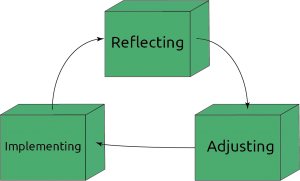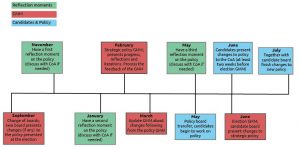Using the Strategic Policy structure
Throughout a year a board works on the current Lucid policy on which they, and previous boards have contributed and have iterated on. This policy structure has a certain workflow which describes how you work with the policy during your year as a board.
The structure gives boards the opportunity to come up with their own focus areas and strategic objectives, which can be placed underneath the values.
Throughout a year the workflow of the board will be iterative. This iterative process consists of reflecting on , adjusting and implementing the policy during the entire year:

Implementing
Before working on the strategic policy boards will first have to write policy. By doing this boards work on the envisioned future for Lucid. This contains adding new focus areas, strategic objectives and goals to the strategic policy, but also building upon existing long term parts of the strategic policy. After having clear directions to work towards as an association the board will be working on the implementation of the strategic policy by working on the set goals. While executing these goals you are implementing the changes you, previous boards and the GMM envisioned to Lucid’s strategy.
Reflecting
Throughout the year the board will also actively reflecting on the strategic policy This means in the first place reflecting on whether a certain goal contributed to Lucid, but also reflecting on whether the focus areas and strategic objectives are still relevant in the current landscape Lucid is in. This is something that should be done internally with the board, but also with the GMM and with advisory organs like the Council of Advice.
Furthermore it is convenient to plan a policy board meeting every 5/6 weeks which you dedicate to discuss all progress on strategic objectives. During these meetings on the one hand you keep track of your progress, and you reflect upon the plans you made and adjust when needed.
Adjusting
After a critical reflection on your strategic policy you might want to adjust plans when choosing another path will get you closer to the envisioned future then the initial ideas. These adjustments or additions are presented during the (policy) GMM.
Policy and the GMM
To communicate the Lucid policy to members the board gives updates during the GMM. When there is significant progress on a certain strategic objective you present the changes within Lucid to the GMM in order to update them, but also to receive feedback on your plans/progress.
Every year there will be three moments the entire policy is presented at a the general members meeting. This is the case at the election GMM, the change of boards GMM and the policy GMM which is about halfway the board year.
At the election GMM the candidate board presents the whole Lucid’s strategic policy from the initial value towards the goals to show the direction Lucid will be heading to in the future. The GMM will give feedback on whether the changes made in the policy are in line with what Lucid should be striving for according to its vision.
During the change of boards GMM the final version of the policy the candidate board made is presented and when approved it becomes Lucid’s official policy for
the upcoming year.
During the change of boards GMM the final version of the policy the candidate board made is presented and when approved it becomes Lucid’s official policy for the upcoming year.
At the policy GMM the policy is presented from the initial value towards the goals. The board presents their progress, reflections and proposed adjustments on the strategic policy. The purpose of this GMM is to evaluate together with the GMM whether the set vision, values, focus areas, strategic objectives and goals are still relevant for the association and will help in bringing Lucid closer to what Lucid should be like according to the vision.
Policy Timeline
To have an idea on how to work with the policy throughout the year in terms of planning you can take this timeline as a guideline. The planning is ofcourse flexible, but do take the steps into account.

Writing Policy
When writing new policy you are looking for parts in Lucid’s strategy which you think should be added, changed or revised. In this way you are looking critically at how the association is now, and where the opportunities lie for improvement. In this way you set new strategic objectives where you want to put attention to, and you plan a step-by-step traject on how to work on this objective; the goals. When writing policy you divide your explanation within multiple steps: The Why, How and What of the strategic objective.
Why: Explains why this objective is important for the association and its values, and why the current strategy should be changed with this strategic objective.
How: Explains what exactly is going to be changed in terms of strategy and why these changes will improve the way the association runs.
What: Gives a short summary of the concrete goals with deadlines which will be implemented. This actually describes a step-by-step plan of what is going to happen within the strategic objective.
The goals have to be set in a SMART way. This means that they have to suffice to certain standards. You should aim to write goals following these guidelines:
1. Specific
a.State what exactly you will do
b. Make use of action words
2. Measurable
a. Providing a way to evaluate
b. Use of metrics or data targets
3. Acceptable
a. Within your scope
b. Possible to accomplish
4. Realistic
a. Makes sense within your function
b. Improves the association in some way
5. Time-bound
a. State when you will get it done
b. Be specific on date or time frame
